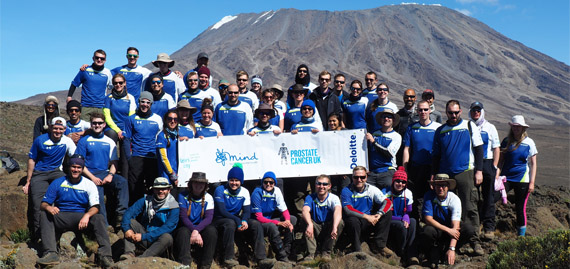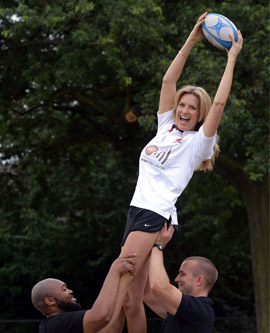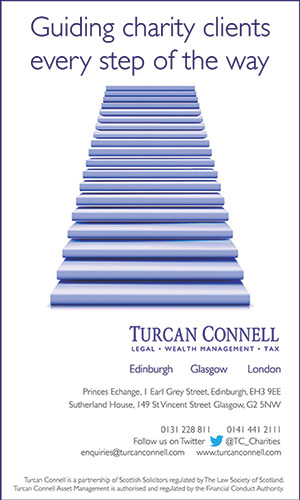NEWS - section 1
London charities benefit from contactless donations
Ten London charities and projects have benefited from contactless donations Londoners have been making on the Transport for London network and in Penny for London participating retailers. Supported by the Mayor’s Fund for London, a total of £30,000 has been awarded to the Evening Standard’s Dispossessed Fund, Magic FM’s Cash for Kids, the Mayor’s Music Fund and seven local charities across the city.
Model Penny Lancaster, a Penny for London ambassador, visited the Dallaglio Foundation, one of the charities in receipt of a grant. The foundation works in 12 London boroughs, using rugby to help change the lives of young people for the better, leaving them more employable, socially responsible and helping them to make positive decisions about their futures. She presented the first cheque to the charity’s chief executive, Rachel Roxburgh, and 30 of the 14-16 year olds in Wandsworth who will directly benefit from the money.
Since October last year, Londoners have been able to donate 1p, or more if they wish, every day they use their contactless card on the Transport for London network and every time they pay using contactless in a Caffe Nero or Leon outlet. Every penny donated is being used to benefit young people from deprived areas of the city.

Accountancy firm's charity challenges raise £1m
239 Deloitte staff, including 25 partners, took part in four challenges across four continents in June and July 2015, raising £1m for its charity partners - Alzheimer’s Society, Mind and Prostate Cancer UK. The challenges included summiting Kilimanjaro, completing a tri-x in Borneo, climbing Mulhacén in mainland Spain and scaling one of the world’s most active volcanoes, Cotopaxi in Ecuador.
The £1m was raised by over 10,543 sponsors and includes over £250,000 matched funding by Deloitte, the largest the firm has ever provided. The Charity Challenge has been Deloitte’s biggest fundraising programme to date and brings the total raised for its national charity partners to £2.5m so far, exceeding the £2m target set in 2013.
Over 600 people supported the participants with fundraising events held at Deloitte’s offices in the UK, including a "Deloitte Dances" showcase judged by celebrity guest and Mind ambassador Frankie Bridge. 70 members of the Deloitte Knitters network also spent over 1,700 hours knitting 160 bobble hats for Charity Challenge participants.
Jeremy Hughes, chief executive of Alzheimer’s Society, Paul Farmer, chief executive of Mind, and Owen Sharp, chief executive of Prostate Cancer UK, all agree: “Hitting the £1m target through the Deloitte Charity Challenge is a fantastic result for the partnership so far and we’ve all been inspired by the energy and goodwill of Deloitte’s staff with their amazing fundraising efforts.
“We are incredibly proud of everything that’s been accomplished, from fundraising to pro bono support, and it’s exciting to think what we can achieve with Deloitte next year. Together, we will get vital support and services to thousands affected by dementia, mental health problems and prostate cancer.”
Deloitte is helping Alzheimer’s Society to fund eight Doctoral Training Centres across the UK to support 53 new PhD students and clinical fellows. Prostate Cancer UK is using the funds to run its awareness raising programmes across the country, engaging with men and women worried about prostate cancer. The funds will also help Mind answer an additional 24,000 calls though its Infoline and distribute more than 80,000 information booklets, allowing the charity to support people in need through their charity shops.
Small charity demand and income pressures
Research released by the Foundation of Social Improvement (FSI) focusing on small charity trends over 18 months shows that increases in demand for services, rising workloads and static income have one in ten small charities fearing closure during the next 12 months.
The Small Charity Index requested information on the challenges faced by small charities during each of the seven quarters since June 2013 to February 2014. The resulting research Shifting Sands of the Small Charity Sector paints a picture of a sector stretched to the limit but holding on. But for how long?, asks the FSI.
Since June 2013 there were significant changes to the perceptions of closure with fear of closure increasing significantly during 2013. This level decreased by March 2014 but by December 2014 it had risen again back to September 2013 levels.
In relation to the challenges the small charity sector is facing, over half of all respondents saw demand for their services increase over the quarter to December 2014. This increase in demand has grown over the past 18 months, which, says the report, reflects the reality that people are increasingly looking to charities for support in these difficult times as other services are cut.
In December 2014 the single greatest challenge was workload, with funding in second place. However, over the 18 months the level of demand for services rose to second place as one of the top three challenges.
In December 2014 two thirds of respondents reported that in spite of increasing demand, paid staff numbers were unchanged. This has remained consistent since June 2013.
The whole issue of financial stability was under focus. Funding, cash flow management and to a lesser extent investment were named as significant challenges by between a quarter and half of the charity respondents.
Voluntary income appears to have remained stable for most charities. Statutory funding has also been stable, however since June 2013 there has been a small but consistent trend towards less statutory funding.
Since June 2013 there has been a 23% increase in small charities holding reserves. However, respondents also stated that levels of reserves have been depleted with 45% reporting they had seen levels reduced in the three months to December 2014.
Retrospective direct marketing VAT liabilities
HMRC has now issued its Revenue & Customs Brief in respect of the VAT liability of direct marketing services using printed matter. Accountancy firm Baker Tilly reports HMRC has taken the view that the delivery of mail packs to members of the public is a standard rated marketing service and the zero rating of mail packs is not possible within a single standard rated marketing service.
Unfortunately many suppliers have historically wrongly zero rated mail packs as a supply of zero rated delivered goods, and HMRC accepts there have been occasions when the correct treatment has been misunderstood based on its guidance.
In view of this, HMRC has introduced a transitional period for suppliers who only provide the delivery of addressed or unaddressed mail. HMRC will not seek to collect VAT prior to 1 August 2015 for suppliers who agree to the transitional arrangements.
However, points out Baker Tilly, in cases where other services are provided, e.g. data cleansing, response handling, HMRC is looking to collect VAT retrospectively which could create significant liabilities for suppliers of such services. Under contractual arrangements, these liabilities may well be passed on to charities with the issue of retrospective VAT only invoices.
Baker Tilly VAT partner Steve Hodgetts says it is questionable whether HMRC’s analysis is correct in law given that the view could be taken that the predominant supply is one of zero rated printed matter.
Moreover, HMRC’s internal guidance directs suppliers to the "package test" allowing zero rating for bulk mailings. Industry practice and instructions from visiting VAT officers have clearly accepted the supply of such services is multiple and the delivery of mail packs is a zero rated service which is separate to any other service the supplier may provide.
Hodgetts comments that given the confusion, and HMRC’s own guidance which has clearly indicated the "package test" should apply to such services, hopefully HMRC’s approach will be reasonable given its failings in providing clear guidance to suppliers, charities and their advisers. Retrospective action should only be sought in exceptional cases.
According to Hodgetts, suppliers of such services should now review their arrangements and consider whether they wish to settle with HMRC or demonstrate they have applied the rules in accordance with HMRC’s clear agreement of the position. If this is the case, suppliers will need to demonstrate that they have been misdirected by HMRC. HMRC, at this stage, has given no assurances in this respect.
Charities should liaise with their suppliers in order to clearly establish both the retrospective and future position in terms of VAT charges. Charities will want to ensure that, if possible, suppliers take advantage of the transitional arrangements rather than passing on the VAT charge to them.
Trustee report obligations concern some charities
Charities are voicing concern that the new trustees reporting requirements introduced this year under the SORP (Statement of Recommended Practice) arrangements are diverting volunteer resources away from core activities.
Sarah Case of national accountants' association MHA, says: " Charities are telling us that they view some of the requirements and additional disclosures as cumbersome and non-value adding, even though the overarching objectives of the new measures are understood and transparency is welcomed by the sector. The effect is that vital management and trustee volunteer resources are being diverted into administrative duties both to understand and comply with the new obligations."
Case points out that the main changes to the trustees' annual report mean that charities will have to provide an explanation of their social investment policies and how any programme related investments have contributed to the achievement of its objectives.
They must also explain the financial effect of significant events and provide a description of the principal risks facing the charity and its subsidiary undertakings, as identified by the charity trustees; a summary of their plans and strategies for managing those risks is also required.
Finally, says Case, charities must disclose their arrangements for setting the pay and remuneration of the charity's key management personnel and any benchmarks or criteria used in setting their pay. A number of these extra requirements will push the smaller possibly less sophisticated charities out of their comfort zones.
Sally Hyman, branch chair of the RSPCA, Llys Nini in Swansea, comments: "We are a small independently registered charity, run by volunteer trustees who give their time freely. My concerns are that by putting the onus on volunteers to find out about and then comply with these new regulations, this will take time away from the delivery of core charitable activities.
"We have already taken professional advice and will undoubtedly have to take more during the preparation of the Annual Report. We are spending more time and money on needless administration and less on the key charitable activities, which could have an adverse impact on both future donations and the number of people willing to act as trustees of smaller charities."
Public cognitive dissonance about charities
Outspoken charity marketing guru Andrew Papworth is asking the question "Should charities redefine themselves for their donors?" in the August issue of his Harvest newsletter. In wide ranging comments about the growing confusion in people's minds about charities, he notes that for the average person what comes to mind when the word "charity" is mentioned, will be words and phrases like "voluntary", "helping the needy", "collection tins", "doing good works", etc.
He writes: "It is hardly surprising, then, that when Mr or Mrs Average Punter reads about senior charity execs getting six-figure salaries plus generous expenses or they visit a charity’s luxurious HQ building in an expensive part of London, or hear about charities having big cash reserves or of a senior exec having moved from an animal charity to a medical charity to a children’s charity, or of a charity being heavily funded by taxpayers, or paying third parties large amounts of money to recruit donors, that they suffer a degree of cognitive dissonance."
Says Papworth: "High salaries, luxury offices, selling your services to the highest bidder rather than working for a cause about which you feel passionate and taking the government’s shilling all run counter to their preconceptions. There is further risk of confusion in the public mind when a charity described as a "non-governmental organisation" receives massive government funding.
"The dissonance is not helped by the fact that definition of a registered charity in the UK is so all-embracing as to include posh, affluent public schools, quasi-governmental bodies like the British Council and nutty fringe religions – a far cry from the dictionary definition of helping the needy. Perhaps it’s about time we created some sub-categories of registered charities to distinguish, for example, those dedicated to helping the needy from those which want to lobby for particular causes and from those who just want a tax-break."
Baking for charity is a big fundraiser
The Great British Bake Off has inspired millions of people to bake for charity, generating huge sums. Research published by the Charities Aid Foundation found that bake sales in Great Britain helped raise an estimated £185 million for charities last year.
A public opinion poll carried out by Populus on behalf of CAF found that in the past 12 months almost 4m people in Great Britain have baked for charity (8%), while nearly 15 million have bought food from a charity bake sale (30%). People spent £12 in the last year on average in fundraising bake sales. Baking for charity is most popular among 25 to 34 year olds with 13% of them having baked for a good cause in the past 12 months.
People living in Yorkshire and Humber are most likely to have made a purchase in a charity bake sale in the past year, with 45% of people living there having done so. This compares with 21% of people in Scotland and Eastern England.
Most people (63%) agree that raising money for charity is a good reason to do something they enjoy while one in five people (20%) even agree that cake tastes better when it has been baked for a good cause.
Charities across the UK have benefited from the efforts of amateur bakers. In 2014 the World’s Biggest Coffee Morning by Macmillan Cancer Support raised a record breaking £25m while bake sales by Marie Curie Cancer Care, Great Ormond Street Hospital, children’s medical research charity Sparks and Help For Heroes also raised substantial sums.
Children’s hospice charity suffers second theft
Local children’s hospice charity Shooting Star Chase has suffered the devastating theft of a donated item worth £500 from its Guildford shop on 30 July 2015. It is the second time items of high value due to raise precious funds for sick children have been stolen from the charity in less than a year.
One of nine Shooting Star Chase charity shops, the Guildford branch in Tungsate received a donation of a mint condition Mulberry bag and displayed the item in the far side of the shop window. The bag, which retails at £895, was available to buy for £400 and the charity was due to receive a total of £500 including Gift Aid once the item was sold.
The Mulberry bag was last seen at 1.30pm on the day of the theft and noticed missing just 45 minutes later, and to add insult to injury a customer who had looked at the bag earlier that day returned after the shoplift hoping to buy the item. The incident follows a burglary in December 2014, where heartless thieves raided Shooting Star Chase’s storage unit just a few weeks before Christmas, pilfering bikes worth a total of £630.
It costs Shooting Star Chase £9.5m a year to maintain the current level of care for over 650 children and their families across Surrey and London, and the charity is reliant on supporters' generosity to keep the service running. The missing Mulberry bag’s value of £500 could pay for two visits from a Hospice at Home nurse during an emergency or five bereaved parents' groups, facilitated by Shooting Star Chase counsellors.
Denise Stenning, the Shooting Star Chase Guildford shop manager, says: “It’s hard to believe someone would steal goods from a charity shop, let alone items of such significant value and from an organisation like Shooting Star Chase that cares for sick children with life-limiting conditions."
There is no insurance cover available for items stolen from charity shops by shoplifters.
Online data under used for personal engagement
The majority of not-for-profits (including charities and membership organisations) admit they are struggling to leverage the power of online data to drive more personalised engagement, thus failing to capitalise on the opportunities to communicate with their supporters through social media channels.
"If you saw a puppy in an advert for a pet charity wearing a Manchester United scarf, would you be more likely to donate than if it wore a Chelsea scarf?", asks Advanced NFP in the study Creating and using digital personas in the not-for-profit sector. Admits Advanced NFP: "It’s a ridiculous question, but at its heart, it’s one that a good digital persona would allow not-for-profit organisations to answer.”
Explains Advanced: "A digital persona sounds complicated and slightly new-fangled. And it is. But only a bit. Fundamentally, it’s about treating all the bits of data about an individual as dots and then using software to join them all together. What comes out of this dot-to-dot is a picture of an individual that can be interrogated and used to model potential behaviour."
The independent report commissioned by Advanced reveals major barriers holding back NFPs: 77% cite a lack of in-house expertise or digital champions as the most common barrier to analysing data about individuals; 71% state data integration is a stumbling block, specifically in linking data sets between existing systems to newer sources of data such as social media.
59% state a lack of access to the right tools to help create and manage "digital personas". Finally, almost half of those surveyed state that senior decision makers still do not fully understand or appreciate the benefits of understanding the "digital persona" of their existing and potential donors.
Simon Fowler of Advanced comments: “If NFPs don’t collect and analyse data from the raft of online social channels, they risk failing to understand and hence adapt to how and where members and supporters are operating in the evolving digital world."
More than half of the report’s respondents say they don’t understand how the "digital persona" of a supporter differs from segmentation, whilst few have read up on the subject (23%) and only 29% have experts they can talk to about online engagement.
When asked to rank what is most important to understand about an individual, the respondents state location, preferred method of communication and age. Less than a third of NFPs actively ask about anything else including social media engagement, social media channels and type of device used.
Despite not actively asking, a third of those NFPs do have the capability to collect more information about their supporters or donors. When building audience profiles, organisations are still predominantly relying on direct interactions, with 47% utilising data collected face to face at charity shops or at fundraising events.
The report also delves into how data about individual members and donors is being used in decision making within the organisation. Only 43% of respondents were able to give an example of how data about individuals is used in key decisions. Where it is used, data driven decision making is most likely to happen in marketing and finance functions, followed by delivery of services and fundraising.
Says Fowler: “Senior decision makers are in danger of missing out on the insight that data driven decisions can offer. This ties into the findings that revealed less than 50% of executives fully appreciate the benefits of understanding the ‘digital persona’ of their existing and potential donors and members.
“With attraction and retention recognised as priorities for NFPs, this research has highlighted a disconnect within many charities around effective engagement.”









